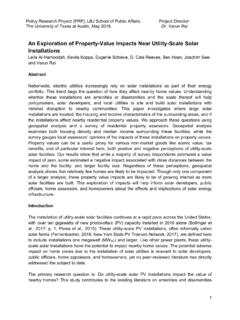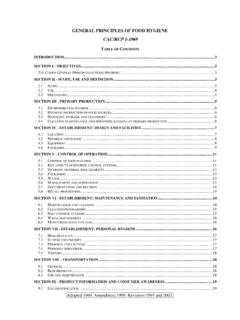Transcription of Utility-Scale Solar Data Update: 2020 Edition
1 Utility-Scale Solar Data Update: 2020 Edition Mark Bolinger1, Joachim Seel1, Dana Robson, Cody Warner Lawrence Berkeley National Laboratory 1 Corresponding authors November 2020. This work was funded by the Department of Energy's Solar Energy Technologies Office, under Contract No. DE-AC02-05CH11231. The views and opinions of the authors expressed herein do not necessarily state or reflect those of the United States Government or any agency thereof, or The Regents of the University of California. Photo source: sPower E NERGY T ECHNOLOGIES AREA E N E R G Y A N AL YS I S AN D E N V I R O N M E N T AL I M P AC T S D I V I S I O N E L E C T R I C I T Y M AR K E T S & P O L I C Y. Disclaimer This document was prepared as an account of work sponsored by the United States Government. While this document is believed to contain correct information, neither the United States Government nor any agency thereof, nor The Regents of the University of California, nor any of their employees, makes any warranty, express or implied, or assumes any legal responsibility for the accuracy, completeness, or usefulness of any information, apparatus, product, or process disclosed, or represents that its use would not infringe privately owned rights.
2 Reference herein to any specific commercial product, process, or service by its trade name, trademark, manufacturer, or otherwise, does not necessarily constitute or imply its endorsement, recommendation, or favoring by the United States Government or any agency thereof, or The Regents of the University of California. The views and opinions of authors expressed herein do not necessarily state or reflect those of the United States Government or any agency thereof, or The Regents of the University of California. Ernest Orlando Lawrence Berkeley National Laboratory is an equal opportunity employer. Copyright Notice This manuscript has been authored by an author at Lawrence Berkeley National Laboratory under Contract No. DE-AC02-05CH11231 with the Department of Energy. The Government retains, and the publisher, by accepting the article for publication, acknowledges, that the Government retains a non-exclusive, paid-up, irrevocable, worldwide license to publish or reproduce the published form of this manuscript, or allow others to do so, for Government purposes.
3 E NERGY T ECHNOLOGIES AREA E N E R G Y A N AL YS I S AN D E N V I R O N M E N T AL I M P AC T S D I V I S I O N E L E C T R I C I T Y M AR K E T S & P O L I C Y. Utility-Scale Solar Data Update: 2020 Edition Purpose and Scope: Summarize publicly available data on key trends in Utility-Scale Solar sector Focus on ground-mounted projects >5 MWAC. There are separate DOE-funded data collection efforts on distributed PV. Focus on historical data, emphasizing the most-recent full calendar year Data and Methods: See summary at end of PowerPoint deck Funding: Department of Energy's Solar Energy Technologies Office Products and Availability: This briefing deck is complemented by a data file and visualizations All products available at: 3. Presentation Contents Deployment and Technology Trends Installed Prices Performance (Capacity Factors). Power Purchase Agreement (PPA) Prices and LCOE.
4 Concentrating Solar Thermal Power (CSP) Plants Capacity in Interconnection Queues Data and Methods 4. What's new this year in the online data set? Consistent use of new regional boundaries Additional data for online and planned hybrid projects Inclusion of LevelTen Energy PV power sales price data Further presentation of trends in levelized energy costs Reorganization and refinement of content and figures 5. Regional boundaries applied in this analysis include the seven independent system operators (ISO) and two non-ISO regions Source: NREL 6. Deployment and Technology Trends E NERGY T ECHNOLOGIES AREA E N E R G Y A N AL YS I S AN D E N V I R O N M E N T AL I M P AC T S D I V I S I O N E L E C T R I C I T Y M AR K E T S & P O L I C Y. Annual and cumulative growth of Solar power capacity Annual Solar Capacity Additions (GW) Cumulative Solar Capacity (GW). 24 200.
5 Utility-Scale CSP. 21 Utility-Scale PV 175. Commercial PV. 18 Residential PV 150. 15 125. PV is in GW DC and CSP is in GW AC. 12 100. Columns show annual capacity 9 75. Areas show cumulative capacity 6 50. 3 25. 0 0. 2007. 2008. 2009. 2010. 2011. 2012. 2013. 2014. 2015. 2016. 2017. 2018. 2019. 2020e 2021e 2022e 2023e 2024e 2025e Installation Year Sources: Wood Mackenzie and SEIA (2010-2019), IREC, Berkeley Lab. Note: Wood Mackenzie and SEIA's definition of Utility-Scale PV capacity differs from LBNL both in size thresholds and treatment of project phase completion. Interactive data visualizations: and 8. Annual capacity additions of different generator types 40 40%. Utility-Scale Solar Total Solar (right axis). Solar Capacity Additions (% of Total). Distributed Solar 35 35%. Annual Capacity Additions (GWAC). Wind Other RE. 30 30%. Other non-RE. Gas 25 25%.
6 Coal Utility-Scale Solar (right axis). 20 20%. 15 15%. 10 10%. 5 Distributed Solar (right axis) 5%. 0 0%. 2007 2008 2009 2010 2011 2012 2013 2014 2015 2016 2017 2018 2019. Sources: ABB, AWEA WindIQ, Wood Mackenzie, Berkeley Lab Note: This graph follows GTM/SEIA's split between distributed and Utility-Scale Solar , rather than our 5 MWAC threshold Over the past 5 years, Solar (31%) and wind (28%) have accounted for 59% of all capacity additions to the grid ( Utility-Scale Solar was 18%). 9. Solar 's market penetration by state Solar generation as a % Solar generation as a %. of in-state generation of in-state load State Utility-Scale Utility-Scale All Solar All Solar Solar Only Solar Only California Vermont Nevada Massachusetts Hawaii Arizona Utah North Carolina New Mexico New Jersey Rest of TOTAL Source: EIA. 10. Utility-Scale Solar projects that were added in 2019.
7 Source: Berkeley Lab Interactive data visualizations: and 11. Utility-Scale Solar projects in operation at the end of 2019. Source: Berkeley Lab Interactive data visualizations: and 12. Annual and cumulative Utility-Scale PV capacity by region Annual Capacity Additions (GWAC) Cumulative Capacity (GWAC). 9 27. West (non-ISO) Columns show annual capacity 8 Southeast (non-ISO) 24. Areas show cumulative capacity 7 SPP 21. PJM. 6 18. NYISO. 5 MISO 15. ISO-NE. 4 12. HAWAII. 3 ERCOT 9. CAISO. 2 6. 1 3. 0 0. 2010 2011 2012 2013 2014 2015 2016 2017 2018 2019. Installation Year Source: Berkeley Lab For the third year in a row, the Southeast led all other regions in 2019 in terms of new Utility-Scale PV capacity additions. 13. Annual and cumulative Utility-Scale PV capacity by module and mounting type Annual Capacity Additions (GWAC) Cumulative Capacity (GWAC). 8 32.
8 7 Tracking Thin-Film 28. Tracking c-Si 6 Fixed-Tilt Thin-Film 24. 5 Fixed-Tilt c-Si 20. 4 16. Columns show annual capacity 3 12. Areas show cumulative capacity 2 8. 1 4. 0 0. 2010 2011 2012 2013 2014 2015 2016 2017 2018 2019. Installation Year Source: Berkeley Lab 88% of all new Utility-Scale PV capacity added in the United States in 2019. employ tracking the highest single-year share yet. 14. Global horizontal irradiance (GHI) by mounting type and installation year Long-Term Average Annual GHI at Newly Built Sites (kWh/m2/day) All PV. 0 2 4 6 8 10 12 14 16 Fixed-Tilt 18 PV 20. Tracking PV. Markers show median values, with 20th and 80th percentiles 2010 2011 2012 2013 2014 2015 2016 2017 2018 2019. n=10 n=35 n=44 n=38 n=64 n=88 n=152 n=164 n=94 n=103. GW GW GW GW GW GW GW GW GW GW. Installation Year Source: Berkeley Lab (project information) and NREL (long-term annual average Solar resource).
9 15. Inverter loading ratio by mounting type and installation year Inverter 0 Loading 2 Ratio (DC:AC). 4 6 8 10 12 14 16 18 20. All PV. Fixed-Tilt PV. Tracking PV. Markers show median values, with 20th and 80th percentiles 2010 2011 2012 2013 2014 2015 2016 2017 2018 2019. n=10 n=35 n=44 n=38 n=64 n=88 n=150 n=164 n=92 n=103. GW GW GW GW GW GW GW GW GW GW. Installation Year Source: Berkeley Lab Note: The Inverter Loading Ratio (ILR, or DC:AC ratio) describes the ratio of project capacity measured in MWDC to the nominal inverter capacity measured in MWAC. 16. Installed Prices E NERGY T ECHNOLOGIES AREA E N E R G Y A N AL YS I S AN D E N V I R O N M E N T AL I M P AC T S D I V I S I O N E L E C T R I C I T Y M AR K E T S & P O L I C Y. Installed price by year (in both DC and AC terms). 0. Installed 4. Price2 (2019 $/W) 6 8 10 12 14 16 18 20 Median ($/W-AC) Individual Projects ($/W-AC) 8 Median ($/W-DC) Individual Projects ($/W-DC).
10 7 6. 5. 4 3. 2. 1 0. 2010 2011 2012 2013 2014 2015 2016 2017 2018 2019 n=10 n=29 n=41 n=38 n=64 n=87 n=146 n=161 n=94 n=51. GW GW GW GW GW GW GW GW GW GW. Installation Year 2019. Sources: Berkeley Lab, Energy Information Administration The median installed price of projects that came online in 2019 fell to $ ($ ), down 20% from 2018 and down by more than 70% from 2010. 18. Installed price by project size in 2019. Installed Price (2019 $/WAC). Columns show median values for 2019 projects, with 20th and 80th percentiles 5-20 MW 20-50 MW 50-100 MW 100-200 MW. n=20 n=13 n=13 n=5. 187 MW 434 MW 942 MW 565 MW. Source: Berkeley Lab Project Size (MWAC). Economies of scale are evident in the 2019 project cost data. 19. Installed price by mounting type and installation year Installed 0 Price2(2019 $/W. 4 AC) 6 8 10 12 14 16 18 20. 8. All PV. 7. Fixed-Tilt PV. 6 Tracking PV.










